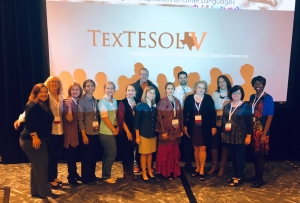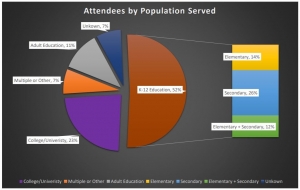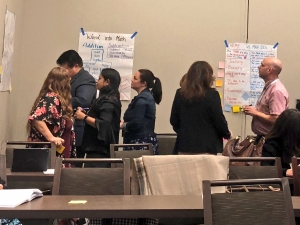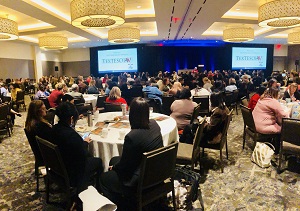|
The TexTESOLV affiliate completes its
40th year in 2019, and we have much to celebrate
on this milestone anniversary. Not only do we have strong partnerships
both with our fellow Texas affiliates (TexTESOL II, III, & IV)
and our Russian sister affiliate Yakutsk TESOL, we also enjoy strong
collaboration with the K-12 school districts within our own region. The
latter, K-12 partnerships, is a hallmark of our affiliate that reflects
the organization’s response to the ever-changing needs of ESL
professionals across Texas.

A photo of the TexTESOLV Board
TexTESOL V was officially founded in February 1979 at the
University of North Texas in Denton. During the fall of that same year,
the affiliate held its first conference. As was the case with many
affiliates during these early years of TexTESOL, many efforts were
centered on teaching adults English – either abroad
or in the United States. And yet as the demographics of Texas’ K-12
schools began to change in the late 1980s, the need to broaden the scope
of the organization became apparent. In those early years, as more and
more immigrants settled in Texas, the number of children in need of ESL
services began to increase dramatically in school districts across the
state. For the 1987-88 school year, the Texas Education Agency reported
that 7% of Texas K-12 students were enrolled in a Bilingual or ESL
program. Compared to the 2017-2018 report which lists the statewide
enrollment at 18.9%, this represents an enormous increase in that
30-year span – from roughly 200,000 English learners in 1988 to well
over a million serviced in 2018. (Texas Education Agency, 1998; 2018).
Not only have the numbers of English Learners increased during
that time span, but so has knowledge of best practices for instructing
them. Texas school districts currently have two options for ESL
programs: 1) pull-out models whereby ESL students leave the mainstream
classroom for lessons with a specialist, or 2) content-based programs
wherein students remain in mainstream classrooms but are instructed by
an ESL-endorsed teacher (Texas Classroom Teachers Association, 2019). As
pull-out models have become less favored in recent years, the
preference for content-based programs, combined with the exponential
demographic growth in English learners, means that Texas has
increasingly high needs for ESL-endorsed K-12 teachers. While initial
ESL endorsement preparation is generally left to education preparation
programs and regional service centers established by the Texas State
Legislature, school districts are finding that simply passing the ESL
certification exam does not necessarily lead to high-quality,
differentiated instruction for ELs. Instead, ESL-endorsed educators need
ongoing support, coaching, and professional development.
Thanks to the incredible foresight of the TexTESOLV Board of
Directors in the late 1980s, the organization realized how critical it
would be to provide professional development to ESL teachers of both children and adults and began to work more
inclusively with the language professionals in K-12 educational
settings. In the years since, the affiliate has developed a number of
organizational practices to ensure our commitment to serving North Texas
school districts. We currently have three interest sections, two
focused on K-12 learners (one elementary, one secondary) and the other
focused on adult learners (a combined higher education/adult education
section). According to our by-laws, each of these three interest
sections is represented by a Board Member on our 15-person Board of
Directors. Additionally, even when non-interest section positions on the
board become available, we remain mindful of our K-12/Higher Ed balance
and recruit new members for whichever area is currently
underrepresented.
Another way we include K-12 educators is both in the
programming and the timing of our annual conference. When we solicit
abstracts for conference talks, we ask submitters to mark on their
proposal which interest section aligns with their talk. We then make
proposal selections to ensure balanced offerings. We also try to select
keynotes who will appeal to as broad of an audience as possible, often
selecting speakers who focus on advocacy and other topics that are of
high interest to all ESL teachers. Additionally, we keep in mind the
budget cycle of the K-12 fiscal year, drawing on the expertise of our
board members to identify the optimal time in the school year that will
ensure inclusion for all of our membership.
Because Texas is divided into four separate TESOL affiliates,
we know that the demographic shifts in our state not only affect us but
also our sister affiliates in the San Antonio, Austin, and Houston
areas. We have observed that they, too, are forming partnerships with
school districts in their areas. At our most recent state conference,
the attendance was broken down roughly 50-50 between K-12 and
Adult/Higher Ed, with Secondary Education slightly more heavily
represented than any of the other groups. (See Table 1.1 below.) This
data tells us that not only were the late 1980’s board members correct
in forecasting the changing needs in our region but that the subsequent
boards have likewise responded to the challenge, allowing our
organization to meet the needs of a wide range of stakeholders
effectively.

Table 1.1
TexTESOL State Conference Data: Attendees by Population Served
One of the more recent outcomes of the collaboration is the
establishment of college scholarships for graduating high school
seniors. As our K-12 partnerships have yielded more successful
conferences, we have begun to give back to our region in a way that both
honors the importance of K-12 ESL education as well as the need for
continued education in adulthood. Our conference goal each year is to
generate enough income not simply to sustain the organization but also
to provide four $1,000 scholarships for any graduating high school
senior who was an English learner during any portion of his or her
elementary or secondary education. We recently selected our 2019
scholarship recipients, who represent four of the 30+ English Learners
that we have been able to sponsor so far. Being able to award these
scholarships is a great point of pride for our affiliate and gives our
work a deeper purpose since we know that in addition to providing
services that broadly impact learners across the region, our efforts are
also specifically improving individual lives.


As we look to the future of TexTESOLV and the next forty years,
we have high hopes that our organization will continue to meet the
ever-changing needs of North Texas ESL professionals and that our strong
collaborations – both international, statewide, and even within our own
diverse membership – will carry us forward.
Citations:
Texas Education Agency. (1998). Enrollment in Texas
public schools, 1998-99. (Report No. 11). Austin,
TX.
Texas Education Agency. (2018). Enrollment in Texas
public schools, 2017-18. (Document No. GE18 601 06). Austin,
TX.
Texas Classroom Teachers Association. (2019). Understanding ESL
certification changes in 2018-19 and beyond. The Classroom
Teacher, Winter 2018-2019, p. 7.
Katie Welch, Ph.D., is an educational consultant
specializing in linguistics, language acquisition, and learning. She is
currently serving as President of TexTESOLV and also served as
conference chair of the 2018 state TexTESOL conference. Katie uses her
10+ years of experience training K-12 and adult ESL teachers to equip
language educators to thrive in the classroom. |

